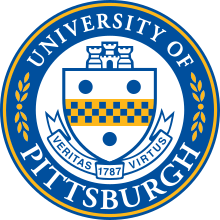University of Pittsburgh at Bradford
 |
|
| Motto | Veritas et Virtus (Latin) |
|---|---|
|
Motto in English
|
Truth and Virtue |
| Type | State-related, Liberal Arts |
| Established | 1963 |
| Endowment | US$22.7 million |
| President | Dr. Livingston Alexander |
|
Academic staff
|
73 (full-time) |
| Students | 1,502 |
| Location | Bradford, Pennsylvania, USA |
| Campus | Rural, 317 acres (1.28 km2) |
| Colors | Blue and gold |
| Athletics | 13 varsity teams NCAA Division III AMCC |
| Nickname | Pitt-Bradford, UPB Panthers |
| Website | www.upb.pitt.edu |
 |
|
The University of Pittsburgh at Bradford, also known as Pitt-Bradford or UPB, is a four-year, baccalaureate degree-granting, state-related university institution that is a regional, residential campus of the University of Pittsburgh located in Bradford, Pennsylvania. Pitt-Bradford was listed among the Best Baccalaureate Colleges in the North by U.S. News & World Report in its "America's Best Colleges 2010" annual college guide, is named to the list of "Best Colleges in the Northeastern Region" by The Princeton Review, and ranked 8th in the nation for satellite campuses with impressive reputations of their own in 2013 by The Best Colleges.
Before the establishment of Pitt-Bradford, there were no institutions of higher education in the northwestern/northcentral region of Pennsylvania. This led Raymond N. Zoerkler, a Bradford geologist with the Hanley and Bird Company, to see the need for an educational resource and came up with the idea in 1962 for a regional campus of the University of Pittsburgh. Supported by Robert Cole, Bradford Hospital's chief administrator, and others, Zoerkler wrote a letter to Edward Litchfield, who was then chancellor of the University of Pittsburgh. Zoerkler proposed that Pitt establish a campus to serve this area of Pennsylvania. On October 16, 1962, Chancellor Litchfield announced that there indeed was a need for accessible quality education in the region and a new Pitt campus was born. Litchfield appointed a committee of community leaders to serve as the advisory board for the new Pitt campus in Bradford. He named Dr. Donald E. Swarts, dean of Pitt-Johnstown, as the first president. J.B. Fisher, president of Kendall Refining, was named the first chairman of the Advisory Board. Swarts immediately began to work with the local Advisory Board to open the University of Pittsburgh at Bradford.
During the summer of 1963, Swarts and the board organized a faculty and bought Hamsher House, a building owned by Bradford Hospital. They renovated the building into classrooms, laboratories, a library and student lounges. On September 3, 1963, less than a year after Chancellor Litchfield's announcement, Pitt-Bradford welcomed its first class of students. This class had a mix of young men and women from all over Pennsylvania, as well as from New Jersey, New York and other states. The newly established campus was a two-year college that offered the beginning of a Pitt undergraduate education. It offered starter and transfer programs to 143 full-time and 145 part-time students. The new college was launched with the financial support of the region. Individuals and organizations in Bradford and surrounding regions contributed $758,000 that year. That enabled the college to start strong and become firmly rooted in Bradford. By 1964, the student body had grown to 380 full-time and 100 part-time students. Dr. Swarts believed that the Pitt-Bradford experience would be enriched by having both commuter and resident students, so the college purchased the 125-room Emery Hotel located in downtown Bradford for student housing.
...
Wikipedia
